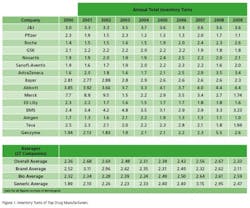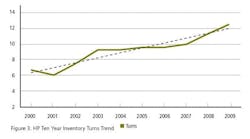Lean Management represents one of the most favored business improvement programs today. Pioneered by Toyota in the 1950s, Lean focuses on eliminating waste in new product development, manufacturing, and distribution in order to cut lead times and investment, increase flexibility, and reduce costs. Its objectives include using less human effort, less inventory, less space, and less time to produce high-quality products as efficiently and economically as possible while being highly responsive to customer demand [1].
As described in a previous article [2], although there is no universally accepted measure of a company’s “Leanness”, inventory turns are a reliable indicator. The trend of inventory turns over time indicates how well a company is progressing in terms of becoming more Lean and improving its processes.
Over the last decade, Lean programs have become popular in the drug industry, as evidenced by the number of published case studies and articles, and conferences devoted to the topic. Unfortunately, the industry as a whole has seen little overall progress, as indicated by the lack of improvement in inventory turns performance.
Figure 1 is a listing of the top drug companies by 2009 revenue. The top companies by revenue were chosen based on the classification of whether they were brand, generic or biopharmaceutical. A total of 27 companies were chosen, consisting of nine biopharmaceutical, 13 brand and five generic. Annual inventory turns data was obtained from Morningstar (www.morningstar.com). Companies are ordered based on their 2009 revenue.
It is difficult to tell from the data whether any pharmaceutical company has truly made progress over the last decade. While there are some companies that have shown improvement over the last five years, there hasn’t been a strong enough trend to draw definitive conclusions.
Much to Gain
Pharmaceutical companies have a lot to gain depending on their success in applying Lean. For example, the U.S. electronics sector was on its deathbed in the early 1980s, but now has once again become the global leader with the likes of IBM, Hewlett Packard, and Dell. They regained this leadership in part through application of Lean methods that originated in Japan, plus adding to this arsenal of process improvement tools with a western-grown improvement methodology called design for manufacturing and assembly (DFMA). The inventory trends of the U.S. companies are reflective of the Lean improvements that have been made. In contrast, the long-range trend lines of two out of three Japanese electronics companies have been flat or heading downward [3].
As an example of what a successful Lean program would look like, HP has successfully applied Lean concepts and has displayed significant improvement in inventory trends over the last decade (Figure 3). From 2000 to 2009, inventory turns improved at an average rate of 6.9%. HP’s upward trend translates directly into growth of free cash flow at a rate of 6.9% percent, with interest on the cash compounded over the 10 year period of lessening funds tied up in inventory. This cash may be spent on product development, equipment, pay increases, share buybacks, dividends, etc. When measuring the success of a Lean program, if the company’s progress isn’t accompanied by a significant upward trend in inventory turns, Lean isn’t being applied correctly.
An example of a leader that transformed another industry is Wal-Mart (Figure 4). In the 1990s, Wal-Mart was able to increase inventory turns at an accelerating rate. From 2000 to 2009, inventory turns improved at an average rate of 2.6% which translates directly into free cash flow improvement of the same rate. Wal-Mart was able to transform an entire industry via their Lean improvement approach and dictate the requirements to successfully compete.
The practices of leading-edge companies have shown the capability to transform industries, such as the electronics example above. It’s clear that pharmaceutical companies have a lot to gain depending on how well they implement Lean management.
The Task for Pharma
Why hasn’t there been significant overall improvement in the pharmaceutical industry? First, implementations have been isolated to what can be called “pockets of excellence” that are typically showcased in magazine articles and at conferences. Unfortunately many of these companies have not been able to consistently apply these concepts across the entire organization. Second, the majority of Lean implementations have been focused on improving manufacturing operations, without an accompanying focus on the rest of the supply chain, such as procurement and distribution. Without focusing on the entire supply chain benefits will be limited; long lead times and high inventories within external logistics pipelines tend to cancel out the greatest Lean successes in operations. Finally, many Lean implementations have failed for various reasons, and/or have not been sustainable—common problems across all industries due to lack of leadership commitment, excessive cost reduction focus, improper project selection and suboptimal execution [4]. The pharmaceutical industry has the advantage of being years behind other industries such as electronics and retail in terms of Lean maturity. By assimilating the lessons learned from other industries pharmaceutical companies can improve inventory turns performance and achieve the full benefits from Lean management.
References
1. Spector, R. How Constraints Management Enhances Lean and Six Sigma. Supply Chain Management Review, January/February 2006.
2. Spector, R. The Impact of Inventory Turns on Speed, Quality, and Costs. Pharmaceutical Manufacturing, June 2009.
3. Schonberger, R. Best Practices in Lean Six Sigma Process Improvement—A Deeper Look. Wiley & Sons, 2008.
4. Spector, R. West, M. The Art of Lean Program Management. Supply Chain Management Review, September 2006.
About the Author
Robert Spector is a Principal with Tunnell Consulting. He is a certified Enterprise Lean/Six Sigma (EL/SS) Black Belt practitioner with 17+ years of management consulting experience serving both manufacturing and service industry clients. He has successfully led projects and teams in multiple industries and sectors, focusing on maximizing business results through strategic and tactical improvements utilizing Lean, Six Sigma, and Theory of Constraints tools and techniques.








